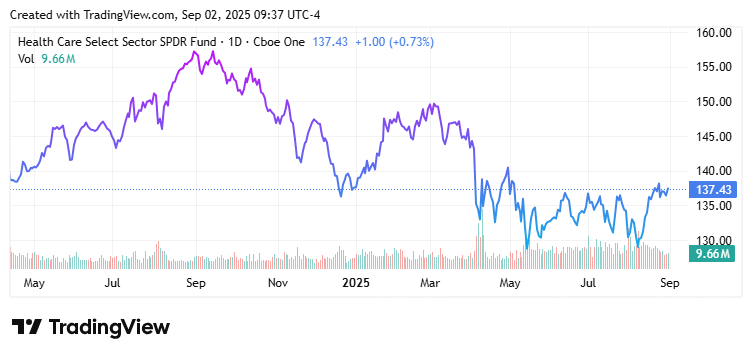The healthcare sector, represented by the , has significantly lagged behind the broader market in 2025. Year-to-date, is down about 1%, while the S&P 500 has continued to show resilience and storm higher toward new all-time highs. Political and economic headwinds have weighed heavily, particularly concerns that a more interventionist administration could tighten regulations around drug pricing and add pressure to insurers.
Significant holdings like , , and have been caught in the crossfire. Rising costs tied to the Affordable Care Act, delays in Medicaid rate hikes, and ongoing headline risks have kept sentiment in check.
At the same time, the sector’s forward P/E ratio of just under 17 sits well below its historical average and meaningfully under the S&P 500’s 23. This discount highlights the market’s caution but also raises the question: with valuations near multi-year lows, could healthcare be setting up for a quiet rebound into year-end?
Early Signs of a Potential Turnaround
Technically, the sector has begun to flash some early signs of strength. After flirting with a major breakdown near $130, XLV recently reversed sharply, reclaiming the $138 level before pulling back slightly to retest it this week. For bullish investors, the key will be whether that area, previously resistance, can establish itself as new support. A successful retest could mark the first major technical confirmation that the downtrend is breaking.
Momentum has also been improving across XLV’s top four holdings, which collectively make up more than 30% of the fund. Johnson & Johnson has surged over 16% this quarter on the back of a significant Q2 earnings beat. UnitedHealth, after months of heavy selling and negative headlines, has bounced more than 8% in August, aided by Warren Buffett’s disclosing a $1.6 billion stake.
, another top weight, is up more than 9% on the month as it looks to retest major resistance around $210, potentially signaling the beginning of a new uptrend. These green shoots among key players could give the sector the recovery it’s lacked so far this year.
Institutional Buying Points to Confidence
One of the more overlooked developments has been the surge in institutional ownership of XLV. During Q2, institutions poured more than $11 billion into the ETF, compared to just $1.3 billion in outflows.

Over the past 12 months, inflows total $16.6 billion versus $7 billion in outflows, a sign that large players have been quietly building exposure despite the sector’s weak price action. This type of accumulation often precedes sector-wide recoveries, as smart money tends to position early.
A Sector at a Crossroads
Despite these positives, healthcare is still facing meaningful challenges. Political rhetoric around drug pricing is unlikely to fade, investigations into billing practices remain a headwind, and investor skepticism about margins for insurers persists.
The sector may also need a broader catalyst to accelerate momentum, such as a shift in monetary policy. If the Federal Reserve begins cutting rates into year-end, as markets currently expect, capital could rotate into undervalued, defensive sectors like healthcare that offer stability and an income component through dividends in a lower-rate world.
For now, healthcare is a sector at a crossroads. Valuations are cheap, technicals are improving, and institutional investors are piling in. Yet sentiment remains fragile, and XLV still needs to prove it can hold key support levels.
While far from confirmed, the ingredients for a quiet turnaround are in place. If rates ease and the sector can continue building on recent strength, healthcare could shift from laggard to quiet leader as 2025 draws to a close.